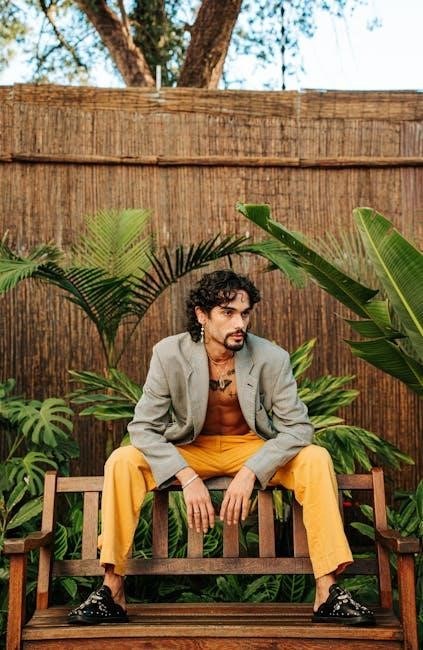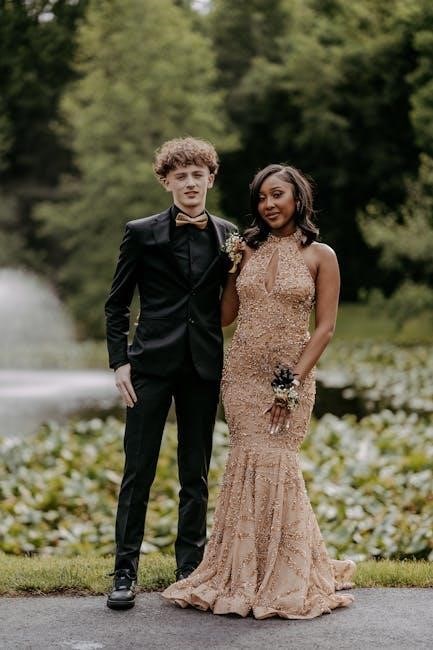The Zoot Suit, a flamboyant outfit from the 1930s-1940s, symbolized rebellion and cultural identity among minority youth. Its exaggerated style and tailored fit defied conventional norms, reflecting a blend of fashion and social statement.
1.1 Definition and Overview
The Zoot Suit was a distinctive, oversized outfit popularized in the 1930s and 1940s, characterized by its exaggerated shoulders, long jacket, and tapered trousers. It symbolized rebellion and cultural pride, particularly among minority youth. The suit’s bold design and tailored fit made it a statement piece, blending fashion with identity. Its origins trace back to African American and Latino communities, where it became a marker of resilience and self-expression during turbulent times.

1.2 Historical Context
The Zoot Suit emerged during the 1930s, gaining prominence among African American and Latino youth as a symbol of cultural identity and defiance against societal norms. Its popularity peaked in the 1940s, coinciding with wartime rationing and racial tensions. The suit became a focal point during the 1943 Zoot Suit Riots in Los Angeles, where it was targeted by servicemen, highlighting deep-seated racial and economic conflicts of the era.
1.3 Cultural Significance
The Zoot Suit was more than attire; it represented a cultural movement. It symbolized resistance, pride, and unity among marginalized communities, particularly Latinos and African Americans, during a time of racial discrimination. The suit became a powerful visual statement of identity, challenging mainstream norms and embodying a spirit of rebellion and self-expression that resonated deeply within these groups, enduring as an iconic symbol of cultural resilience and heritage.

The Design and Style of Zoot Suits
Zoot Suits featured exaggerated silhouettes with wide shoulders, tapered waists, and full, flared legs. Bold patterns, vibrant colors, and luxurious fabrics emphasized their flamboyant, rebellious style.
2.1 Key Features of Zoot Suits
Zoot Suits were known for their exaggerated silhouette, featuring wide, padded shoulders, a tapered waist, and full, flared legs that created a dramatic drape. The jackets were long and boxy, often with a nipped-in waist and high shoulders, while the pants were wide-legged and sometimes cuffed. The suits were typically made from luxurious fabrics like wool or rayon, in bold patterns and vibrant colors, emphasizing their flamboyant, rebellious style.
Accessories like wide-brimmed hats and long, decorative chains complemented the look.
2.2 Fabrics and Colors
Zoot Suits were crafted from luxurious fabrics such as wool, rayon, and silk, often in bold patterns like plaid, stripes, and checks. The suits featured vibrant colors, contrasting with the austerity of the 1940s, making them visually striking. The fabric choices and bright hues emphasized the wearer’s rebellious and flamboyant style, creating a sharp contrast to the muted tones of wartime fashion.
These elements were central to the Zoot Suit’s iconic and defiant image.
2.3 Accessories and Embellishments
Zoot Suits were often complemented by bold accessories, such as wide-brimmed hats, pointed-toe shoes, and ornate belt buckles. Jewelry like chunky chains and decorative pins added flair, while suspenders and patterned socks enhanced the overall look. Embellishments included intricate stitching, decorative buttons, and patterned fabrics, further emphasizing the suit’s flamboyant style. These details showcased the wearer’s individuality and rebellion against mainstream fashion norms.
This made the Zoot Suit a true statement piece.
The Rise of Zoot Suits in Popular Culture
Zoot Suits gained prominence in the 1940s as a symbol of cultural identity and rebellion among minority youth, embodying defiance and self-expression through their bold, exaggerated style.
They became a powerful statement in fashion and music, influencing future trends and solidifying their place in history as a cultural phenomenon.
3.1 The Zoot Suit Riot and Its Impact
The 1943 Zoot Suit Riots in Los Angeles erupted as tensions between Mexican-American youths and U.S. servicemen on leave boiled over. The flashy suits, seen as rebellious symbols, were targeted by servicemen, sparking violent clashes. Media portrayal of the Pachucos as criminals intensified racial profiling. The riots highlighted deep-seated racial and cultural divides, leading to a ban on zoot suits and a wave of anti-Mexican sentiment. This event became a pivotal moment in the struggle for Latino rights and identity.
The aftermath saw the repeal of the “Zoot Suit Ordinance,” but the riots left lasting scars, underscoring the suit’s role as both a fashion statement and a symbol of resistance.
3.2 Influence on Fashion and Music
The zoot suit’s bold style influenced post-war fashion, inspiring punk and hip-hop aesthetics. Its exaggerated silhouette and vibrant colors became a symbol of rebellion, echoed in later countercultural movements. In music, it was embraced by jazz and swing artists, reflecting the era’s vibrant energy. The suit’s fusion of fashion and identity helped bridge cultural gaps, leaving a lasting mark on both style and sound.
Its legacy continues to inspire modern designers and musicians alike.
3.3 Iconic Figures Associated with Zoot Suits
Iconic figures like Cab Calloway and Malcolm X embraced the zoot suit, using it to express cultural identity and rebellion; Calloway’s flamboyant performances popularized the suit, while Malcolm X’s early adopter status highlighted its significance in marginalized communities. These figures transformed the zoot suit into a symbol of defiance and style, influencing future fashion and cultural movements.
Their association cemented the suit’s legacy as both a fashion statement and a political symbol.
The Decline and Revival of Zoot Suits
The zoot suit declined post-WWII due to social backlash and the Zoot Suit Riots, but saw a revival in the 1970s and 1980s among cultural groups.
4.1 Factors Leading to Decline
The zoot suit’s popularity waned due to societal backlash and economic constraints. The Zoot Suit Riots of 1943, fueled by racial tensions, targeted wearers, leading to public disapproval. Additionally, WWII fabric shortages made production difficult, and the suits were deemed unpatriotic due to their extravagant use of material; These factors collectively contributed to their decline in mainstream fashion by the late 1940s.
4.2 Modern Revival and Relevance
The zoot suit has seen a modern resurgence, celebrated for its historical significance and cultural impact. Designers incorporate its bold, oversized silhouette into contemporary fashion, blending vintage flair with modern aesthetics. Its revival is also driven by nostalgia for its rebellious roots and its symbol of identity for marginalized communities. Today, it remains a powerful symbol of resistance and style, appealing to new generations seeking unique expression.
4.3 Contemporary Design Adaptations
Modern zoot suits blend classic elements with fresh twists, such as slim-fit cuts, vibrant colors, and innovative fabrics like linen or velvet. Designers often mix traditional patterns with modern streetwear influences, creating a fusion of styles. Accessories like bold hats and chunky jewelry enhance the look, making it versatile for both formal and casual settings. These adaptations ensure the zoot suit remains relevant, appealing to fashion enthusiasts while honoring its cultural legacy.

The Role of Zoot Suits in Literature and Film

The zoot suit, a cultural icon of rebellion, is prominently featured in literature and film, symbolizing minority identity and resistance, especially during the 1940s Zoot Suit Riots, underscoring its social impact.
5.1 Representation in Literature
The Zoot Suit is a significant symbol in literature, often representing rebellion and cultural identity. Its bold style and association with minority youth during the 1940s Zoot Suit Riots make it a powerful metaphor for resistance against societal norms. Authors use it to explore themes of identity, discrimination, and social justice, reflecting its enduring impact on cultural narratives and influencing contemporary literary works that address similar struggles.
5.2 Portrayal in Movies and Media
Zoot Suits have been prominently featured in films and media, often symbolizing rebellion and cultural identity. Movies like Zoot Suit (1981) highlight its role in the 1943 riots, while others use it to depict Latino youth resistance. Media portrayals emphasize its flamboyant style and historical significance, linking it to themes of social justice and cultural pride, making it a lasting visual symbol in cinematic and narrative storytelling.
5.3 Symbolism and Metaphorical Meaning
The Zoot Suit symbolized rebellion, cultural identity, and resistance against societal norms. Its exaggerated design represented a defiance of conformity and oppression, particularly for Latino youth. The suit became a metaphor for unity and pride, embodying the struggle for equality during the Zoot Suit Riots. Its flashy style and tailored fit signified a bold rejection of mainstream values, making it a powerful visual symbol of marginalized communities’ resilience and identity.
The Zoot Suit as a Cultural Icon
The Zoot Suit became a cultural icon, symbolizing resistance and pride for marginalized communities, transcending fashion to represent identity and resilience in the face of oppression.
6.1 Identity and Belonging
The Zoot Suit served as a powerful symbol of identity, allowing wearers to express their cultural heritage and belonging to specific communities. It became a uniform of solidarity, especially among Latino and African American youth, signifying pride and resistance against societal norms. The suit’s distinctive style helped individuals assert their unique identities while fostering a sense of unity and shared experience within their groups, transcending mere fashion.

6.2 Political and Social Statements
The Zoot Suit became a symbol of defiance and resistance, particularly during the 1940s. It challenged societal norms and authority, often worn by minority groups to assert their identity and reject discrimination. The suit’s flashy style was seen as a political statement, rejecting conformity and embracing cultural pride. This outward rebellion sparked tensions, as seen in the Zoot Suit Riots, where it became a focal point of racial and social conflict, highlighting its power as a symbol of resistance and change.
6.3 Legacy in Fashion History
The Zoot Suit left an indelible mark on fashion history, influencing future designers with its bold, oversized silhouette. Its innovative tailoring and use of vibrant fabrics inspired later movements, such as punk and hip-hop fashion. The suit’s cultural significance transcended mere clothing, becoming a timeless symbol of rebellion and self-expression. Its enduring influence is celebrated in modern fashion, ensuring its place as a landmark in sartorial history.

The Zoot Suit in the Digital Age
The Zoot Suit’s legacy thrives in the digital age through PDF resources, online forums, and digital design tools, offering insights into its history and modern reinterpretations.
7.1 PDF Resources and Guides
Zoot Suit PDFs provide comprehensive insights into its history, design, and cultural impact. These guides often include detailed patterns, historical context, and styling tips. Available on academic and fashion websites, they serve as valuable resources for researchers, designers, and enthusiasts. Many PDFs explore the suit’s significance in fashion history and its influence on modern trends, making them essential for understanding its enduring legacy and contemporary relevance.
7.2 Online Communities and Forums
Online communities and forums dedicated to the Zoot Suit foster discussions, shared resources, and historical insights. Enthusiasts exchange PDF guides, patterns, and vintage photographs, while experts provide detailed analyses. These platforms serve as hubs for fashion historians, designers, and enthusiasts, offering a space to explore the suit’s cultural and historical significance. They also facilitate connections among fans worldwide, creating a vibrant community around this iconic fashion statement.
7.3 Digital Design and Customization
Digital tools now enable the creation of custom Zoot Suits, blending traditional styles with modern aesthetics. Design software allows users to choose fabrics, colors, and accessories, creating unique looks. PDF templates and online tutorials guide DIY enthusiasts, while digital platforms connect customers with tailors for bespoke suits. This fusion of technology and craftsmanship ensures the Zoot Suit’s legacy endures, appealing to new generations through innovative design and personalization.
The Zoot Suit remains a cultural icon, blending rebellion and style. Its influence continues to inspire fashion, music, and identity, ensuring its legacy endures through modern adaptations.
8.1 Final Thoughts on Cultural Impact
The Zoot Suit emerged as a powerful cultural symbol, empowering marginalized communities and challenging societal norms. Its flamboyant design and association with minority groups underscored identity and resistance. The Zoot Suit Riot highlighted racial tensions, cementing its role in cultural conflict. Despite its controversial past, the suit remains a celebrated emblem of resilience, unity, and self-expression, leaving a lasting impact on fashion and social history.
8.2 Future Trends and Predictions
The Zoot Suit’s resurgence is predicted to grow, driven by nostalgia and cultural appreciation. Designers may blend vintage elements with modern sustainability, appealing to eco-conscious consumers. Customization and digital tools could enhance accessibility, allowing wearers to personalize suits. As fashion evolves, the Zoot Suit may reemerge as a symbol of identity and creativity, bridging historical roots with contemporary style, ensuring its relevance in future fashion landscapes.
8.3 Encouraging Further Exploration
The Zoot Suit’s rich history and cultural significance invite deeper exploration. Readers are encouraged to delve into historical texts, documentaries, and firsthand accounts to appreciate its impact. Engaging with modern adaptations and designers can also provide fresh insights. By exploring its evolution, one can understand its enduring influence on fashion and identity, fostering a greater appreciation for its role in shaping cultural narratives and personal expression.
